Financial Analysis: Break-Even, Profit, and Management Accounting
VerifiedAdded on 2023/01/07
|17
|6073
|52
Homework Assignment
AI Summary
This assignment delves into break-even analysis and management accounting. The first question calculates the break-even point, profit margins, and the impact of changes in costs and selling prices for Solent Ltd's sandals. It also discusses the limitations of break-even analysis. The second question critically examines the necessity of management accounting, especially given the legal requirements of financial accounting. It explores how management accountants can achieve their objectives through various techniques, emphasizing the importance of internal record-keeping for strategic decision-making, coordination, organization, customer satisfaction, planning, efficiency improvements, communication, and motivation within a business context. The assignment provides detailed calculations and critical discussions to illustrate these concepts.

Online Exam
Paraphrase This Document
Need a fresh take? Get an instant paraphrase of this document with our AI Paraphraser
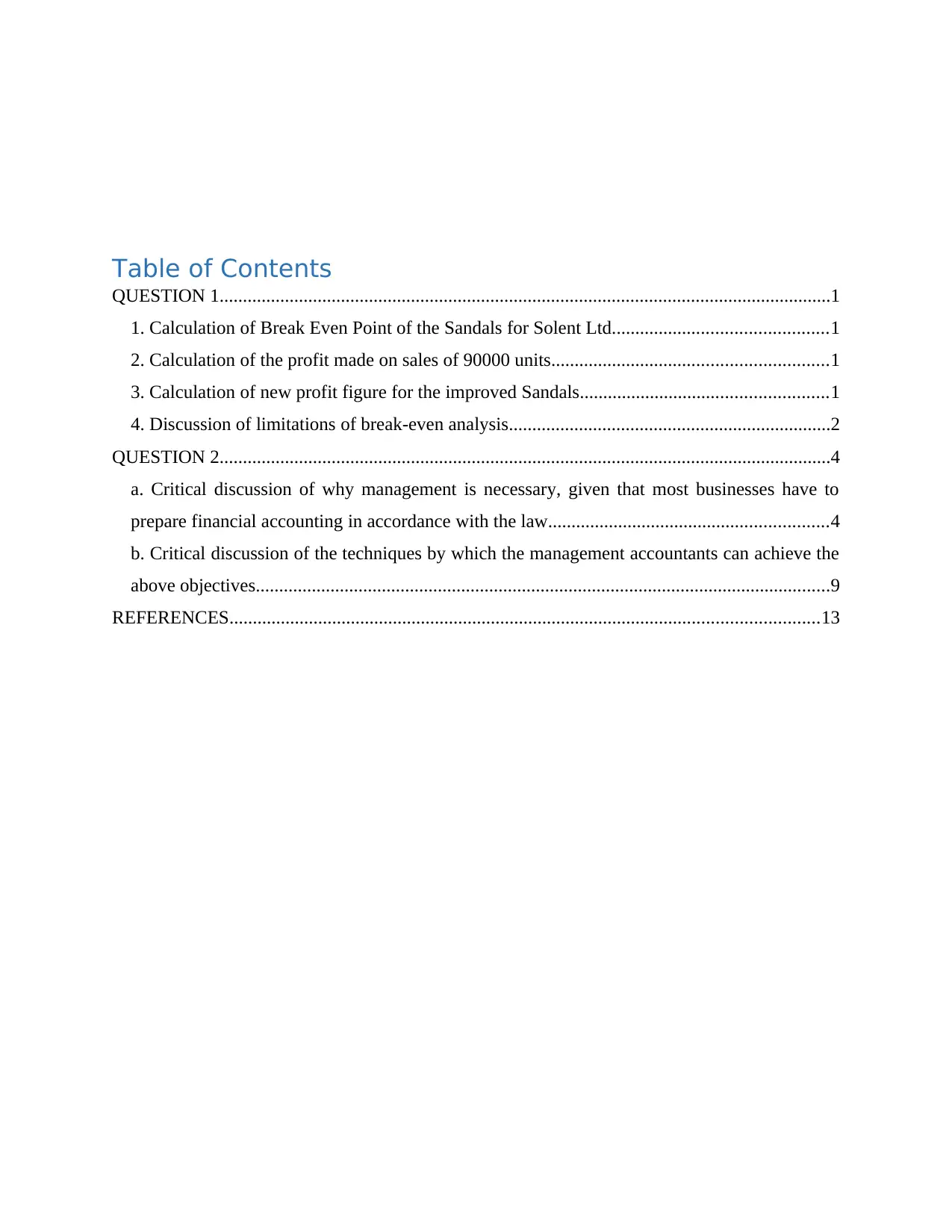
Table of Contents
QUESTION 1...................................................................................................................................1
1. Calculation of Break Even Point of the Sandals for Solent Ltd..............................................1
2. Calculation of the profit made on sales of 90000 units...........................................................1
3. Calculation of new profit figure for the improved Sandals.....................................................1
4. Discussion of limitations of break-even analysis.....................................................................2
QUESTION 2...................................................................................................................................4
a. Critical discussion of why management is necessary, given that most businesses have to
prepare financial accounting in accordance with the law............................................................4
b. Critical discussion of the techniques by which the management accountants can achieve the
above objectives...........................................................................................................................9
REFERENCES..............................................................................................................................13
QUESTION 1...................................................................................................................................1
1. Calculation of Break Even Point of the Sandals for Solent Ltd..............................................1
2. Calculation of the profit made on sales of 90000 units...........................................................1
3. Calculation of new profit figure for the improved Sandals.....................................................1
4. Discussion of limitations of break-even analysis.....................................................................2
QUESTION 2...................................................................................................................................4
a. Critical discussion of why management is necessary, given that most businesses have to
prepare financial accounting in accordance with the law............................................................4
b. Critical discussion of the techniques by which the management accountants can achieve the
above objectives...........................................................................................................................9
REFERENCES..............................................................................................................................13
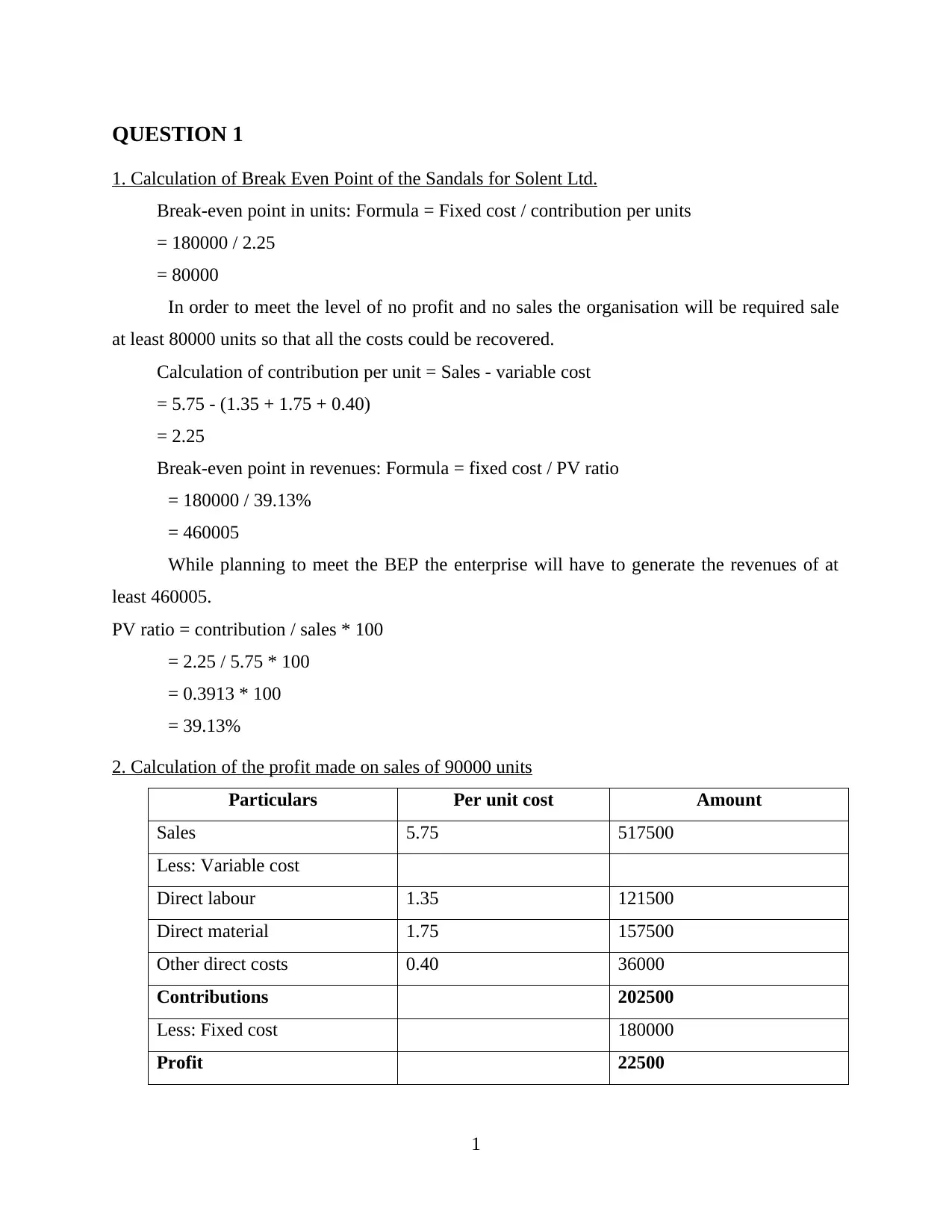
QUESTION 1
1. Calculation of Break Even Point of the Sandals for Solent Ltd.
Break-even point in units: Formula = Fixed cost / contribution per units
= 180000 / 2.25
= 80000
In order to meet the level of no profit and no sales the organisation will be required sale
at least 80000 units so that all the costs could be recovered.
Calculation of contribution per unit = Sales - variable cost
= 5.75 - (1.35 + 1.75 + 0.40)
= 2.25
Break-even point in revenues: Formula = fixed cost / PV ratio
= 180000 / 39.13%
= 460005
While planning to meet the BEP the enterprise will have to generate the revenues of at
least 460005.
PV ratio = contribution / sales * 100
= 2.25 / 5.75 * 100
= 0.3913 * 100
= 39.13%
2. Calculation of the profit made on sales of 90000 units
Particulars Per unit cost Amount
Sales 5.75 517500
Less: Variable cost
Direct labour 1.35 121500
Direct material 1.75 157500
Other direct costs 0.40 36000
Contributions 202500
Less: Fixed cost 180000
Profit 22500
1
1. Calculation of Break Even Point of the Sandals for Solent Ltd.
Break-even point in units: Formula = Fixed cost / contribution per units
= 180000 / 2.25
= 80000
In order to meet the level of no profit and no sales the organisation will be required sale
at least 80000 units so that all the costs could be recovered.
Calculation of contribution per unit = Sales - variable cost
= 5.75 - (1.35 + 1.75 + 0.40)
= 2.25
Break-even point in revenues: Formula = fixed cost / PV ratio
= 180000 / 39.13%
= 460005
While planning to meet the BEP the enterprise will have to generate the revenues of at
least 460005.
PV ratio = contribution / sales * 100
= 2.25 / 5.75 * 100
= 0.3913 * 100
= 39.13%
2. Calculation of the profit made on sales of 90000 units
Particulars Per unit cost Amount
Sales 5.75 517500
Less: Variable cost
Direct labour 1.35 121500
Direct material 1.75 157500
Other direct costs 0.40 36000
Contributions 202500
Less: Fixed cost 180000
Profit 22500
1
⊘ This is a preview!⊘
Do you want full access?
Subscribe today to unlock all pages.

Trusted by 1+ million students worldwide
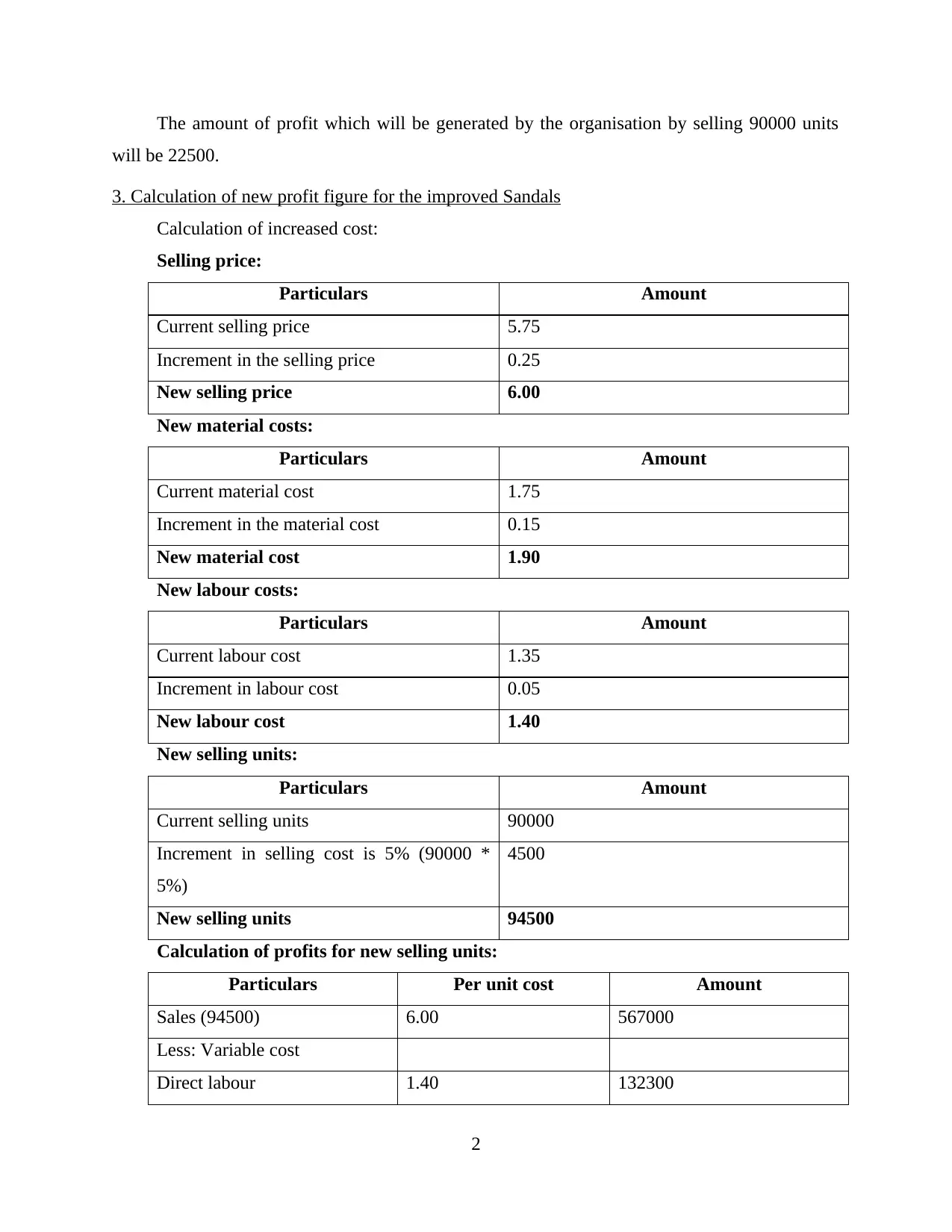
The amount of profit which will be generated by the organisation by selling 90000 units
will be 22500.
3. Calculation of new profit figure for the improved Sandals
Calculation of increased cost:
Selling price:
Particulars Amount
Current selling price 5.75
Increment in the selling price 0.25
New selling price 6.00
New material costs:
Particulars Amount
Current material cost 1.75
Increment in the material cost 0.15
New material cost 1.90
New labour costs:
Particulars Amount
Current labour cost 1.35
Increment in labour cost 0.05
New labour cost 1.40
New selling units:
Particulars Amount
Current selling units 90000
Increment in selling cost is 5% (90000 *
5%)
4500
New selling units 94500
Calculation of profits for new selling units:
Particulars Per unit cost Amount
Sales (94500) 6.00 567000
Less: Variable cost
Direct labour 1.40 132300
2
will be 22500.
3. Calculation of new profit figure for the improved Sandals
Calculation of increased cost:
Selling price:
Particulars Amount
Current selling price 5.75
Increment in the selling price 0.25
New selling price 6.00
New material costs:
Particulars Amount
Current material cost 1.75
Increment in the material cost 0.15
New material cost 1.90
New labour costs:
Particulars Amount
Current labour cost 1.35
Increment in labour cost 0.05
New labour cost 1.40
New selling units:
Particulars Amount
Current selling units 90000
Increment in selling cost is 5% (90000 *
5%)
4500
New selling units 94500
Calculation of profits for new selling units:
Particulars Per unit cost Amount
Sales (94500) 6.00 567000
Less: Variable cost
Direct labour 1.40 132300
2
Paraphrase This Document
Need a fresh take? Get an instant paraphrase of this document with our AI Paraphraser
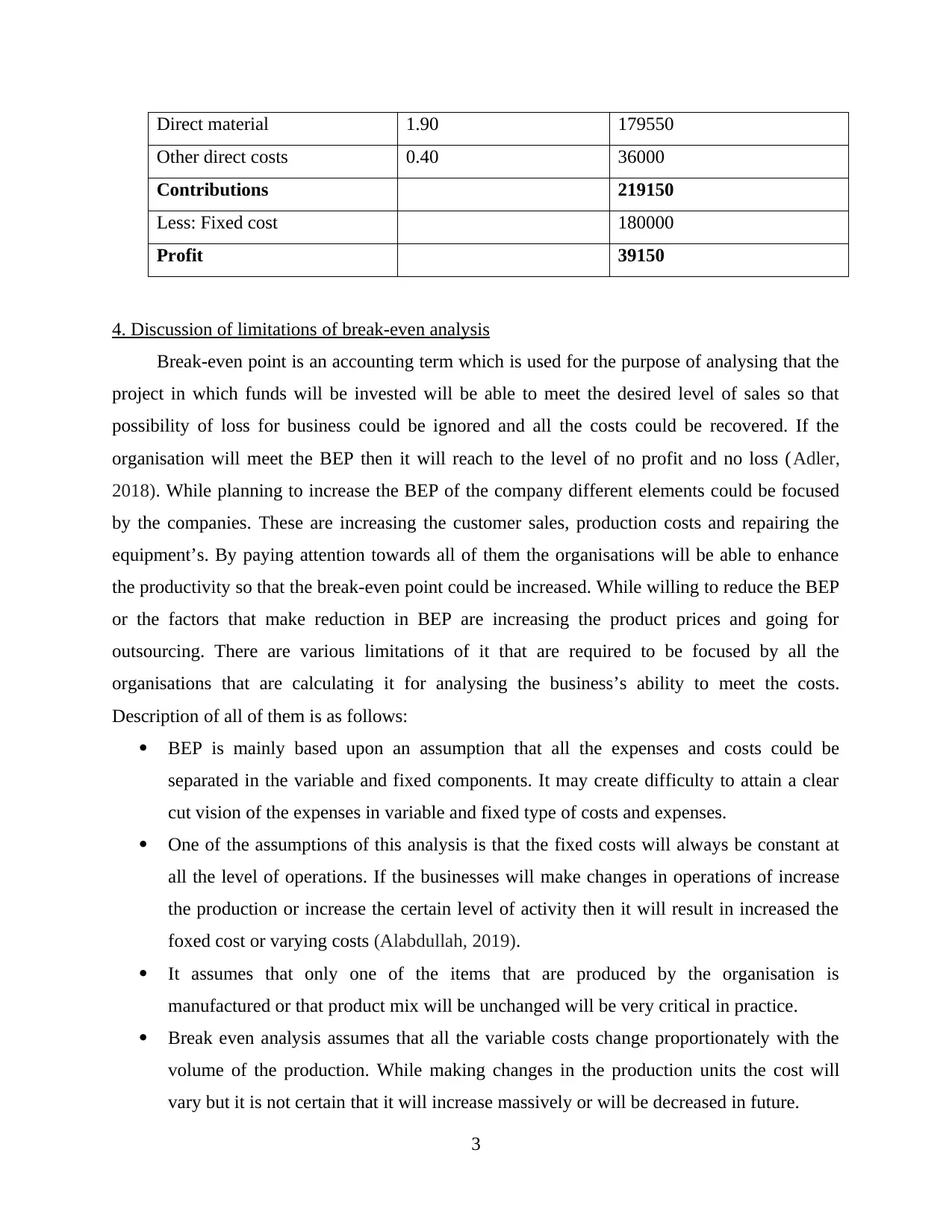
Direct material 1.90 179550
Other direct costs 0.40 36000
Contributions 219150
Less: Fixed cost 180000
Profit 39150
4. Discussion of limitations of break-even analysis
Break-even point is an accounting term which is used for the purpose of analysing that the
project in which funds will be invested will be able to meet the desired level of sales so that
possibility of loss for business could be ignored and all the costs could be recovered. If the
organisation will meet the BEP then it will reach to the level of no profit and no loss (Adler,
2018). While planning to increase the BEP of the company different elements could be focused
by the companies. These are increasing the customer sales, production costs and repairing the
equipment’s. By paying attention towards all of them the organisations will be able to enhance
the productivity so that the break-even point could be increased. While willing to reduce the BEP
or the factors that make reduction in BEP are increasing the product prices and going for
outsourcing. There are various limitations of it that are required to be focused by all the
organisations that are calculating it for analysing the business’s ability to meet the costs.
Description of all of them is as follows:
BEP is mainly based upon an assumption that all the expenses and costs could be
separated in the variable and fixed components. It may create difficulty to attain a clear
cut vision of the expenses in variable and fixed type of costs and expenses.
One of the assumptions of this analysis is that the fixed costs will always be constant at
all the level of operations. If the businesses will make changes in operations of increase
the production or increase the certain level of activity then it will result in increased the
foxed cost or varying costs (Alabdullah, 2019).
It assumes that only one of the items that are produced by the organisation is
manufactured or that product mix will be unchanged will be very critical in practice.
Break even analysis assumes that all the variable costs change proportionately with the
volume of the production. While making changes in the production units the cost will
vary but it is not certain that it will increase massively or will be decreased in future.
3
Other direct costs 0.40 36000
Contributions 219150
Less: Fixed cost 180000
Profit 39150
4. Discussion of limitations of break-even analysis
Break-even point is an accounting term which is used for the purpose of analysing that the
project in which funds will be invested will be able to meet the desired level of sales so that
possibility of loss for business could be ignored and all the costs could be recovered. If the
organisation will meet the BEP then it will reach to the level of no profit and no loss (Adler,
2018). While planning to increase the BEP of the company different elements could be focused
by the companies. These are increasing the customer sales, production costs and repairing the
equipment’s. By paying attention towards all of them the organisations will be able to enhance
the productivity so that the break-even point could be increased. While willing to reduce the BEP
or the factors that make reduction in BEP are increasing the product prices and going for
outsourcing. There are various limitations of it that are required to be focused by all the
organisations that are calculating it for analysing the business’s ability to meet the costs.
Description of all of them is as follows:
BEP is mainly based upon an assumption that all the expenses and costs could be
separated in the variable and fixed components. It may create difficulty to attain a clear
cut vision of the expenses in variable and fixed type of costs and expenses.
One of the assumptions of this analysis is that the fixed costs will always be constant at
all the level of operations. If the businesses will make changes in operations of increase
the production or increase the certain level of activity then it will result in increased the
foxed cost or varying costs (Alabdullah, 2019).
It assumes that only one of the items that are produced by the organisation is
manufactured or that product mix will be unchanged will be very critical in practice.
Break even analysis assumes that all the variable costs change proportionately with the
volume of the production. While making changes in the production units the cost will
vary but it is not certain that it will increase massively or will be decreased in future.
3
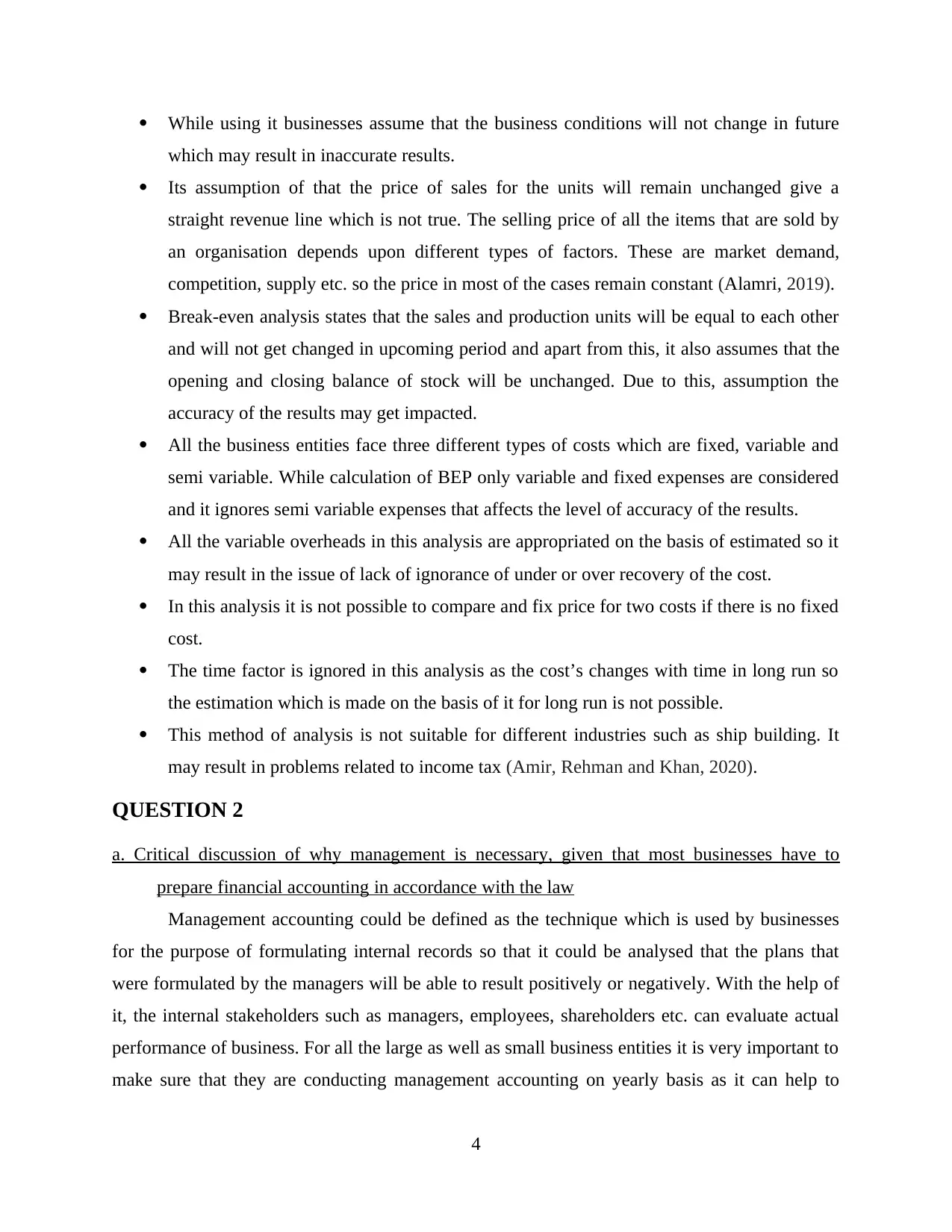
While using it businesses assume that the business conditions will not change in future
which may result in inaccurate results.
Its assumption of that the price of sales for the units will remain unchanged give a
straight revenue line which is not true. The selling price of all the items that are sold by
an organisation depends upon different types of factors. These are market demand,
competition, supply etc. so the price in most of the cases remain constant (Alamri, 2019).
Break-even analysis states that the sales and production units will be equal to each other
and will not get changed in upcoming period and apart from this, it also assumes that the
opening and closing balance of stock will be unchanged. Due to this, assumption the
accuracy of the results may get impacted.
All the business entities face three different types of costs which are fixed, variable and
semi variable. While calculation of BEP only variable and fixed expenses are considered
and it ignores semi variable expenses that affects the level of accuracy of the results.
All the variable overheads in this analysis are appropriated on the basis of estimated so it
may result in the issue of lack of ignorance of under or over recovery of the cost.
In this analysis it is not possible to compare and fix price for two costs if there is no fixed
cost.
The time factor is ignored in this analysis as the cost’s changes with time in long run so
the estimation which is made on the basis of it for long run is not possible.
This method of analysis is not suitable for different industries such as ship building. It
may result in problems related to income tax (Amir, Rehman and Khan, 2020).
QUESTION 2
a. Critical discussion of why management is necessary, given that most businesses have to
prepare financial accounting in accordance with the law
Management accounting could be defined as the technique which is used by businesses
for the purpose of formulating internal records so that it could be analysed that the plans that
were formulated by the managers will be able to result positively or negatively. With the help of
it, the internal stakeholders such as managers, employees, shareholders etc. can evaluate actual
performance of business. For all the large as well as small business entities it is very important to
make sure that they are conducting management accounting on yearly basis as it can help to
4
which may result in inaccurate results.
Its assumption of that the price of sales for the units will remain unchanged give a
straight revenue line which is not true. The selling price of all the items that are sold by
an organisation depends upon different types of factors. These are market demand,
competition, supply etc. so the price in most of the cases remain constant (Alamri, 2019).
Break-even analysis states that the sales and production units will be equal to each other
and will not get changed in upcoming period and apart from this, it also assumes that the
opening and closing balance of stock will be unchanged. Due to this, assumption the
accuracy of the results may get impacted.
All the business entities face three different types of costs which are fixed, variable and
semi variable. While calculation of BEP only variable and fixed expenses are considered
and it ignores semi variable expenses that affects the level of accuracy of the results.
All the variable overheads in this analysis are appropriated on the basis of estimated so it
may result in the issue of lack of ignorance of under or over recovery of the cost.
In this analysis it is not possible to compare and fix price for two costs if there is no fixed
cost.
The time factor is ignored in this analysis as the cost’s changes with time in long run so
the estimation which is made on the basis of it for long run is not possible.
This method of analysis is not suitable for different industries such as ship building. It
may result in problems related to income tax (Amir, Rehman and Khan, 2020).
QUESTION 2
a. Critical discussion of why management is necessary, given that most businesses have to
prepare financial accounting in accordance with the law
Management accounting could be defined as the technique which is used by businesses
for the purpose of formulating internal records so that it could be analysed that the plans that
were formulated by the managers will be able to result positively or negatively. With the help of
it, the internal stakeholders such as managers, employees, shareholders etc. can evaluate actual
performance of business. For all the large as well as small business entities it is very important to
make sure that they are conducting management accounting on yearly basis as it can help to
4
⊘ This is a preview!⊘
Do you want full access?
Subscribe today to unlock all pages.

Trusted by 1+ million students worldwide
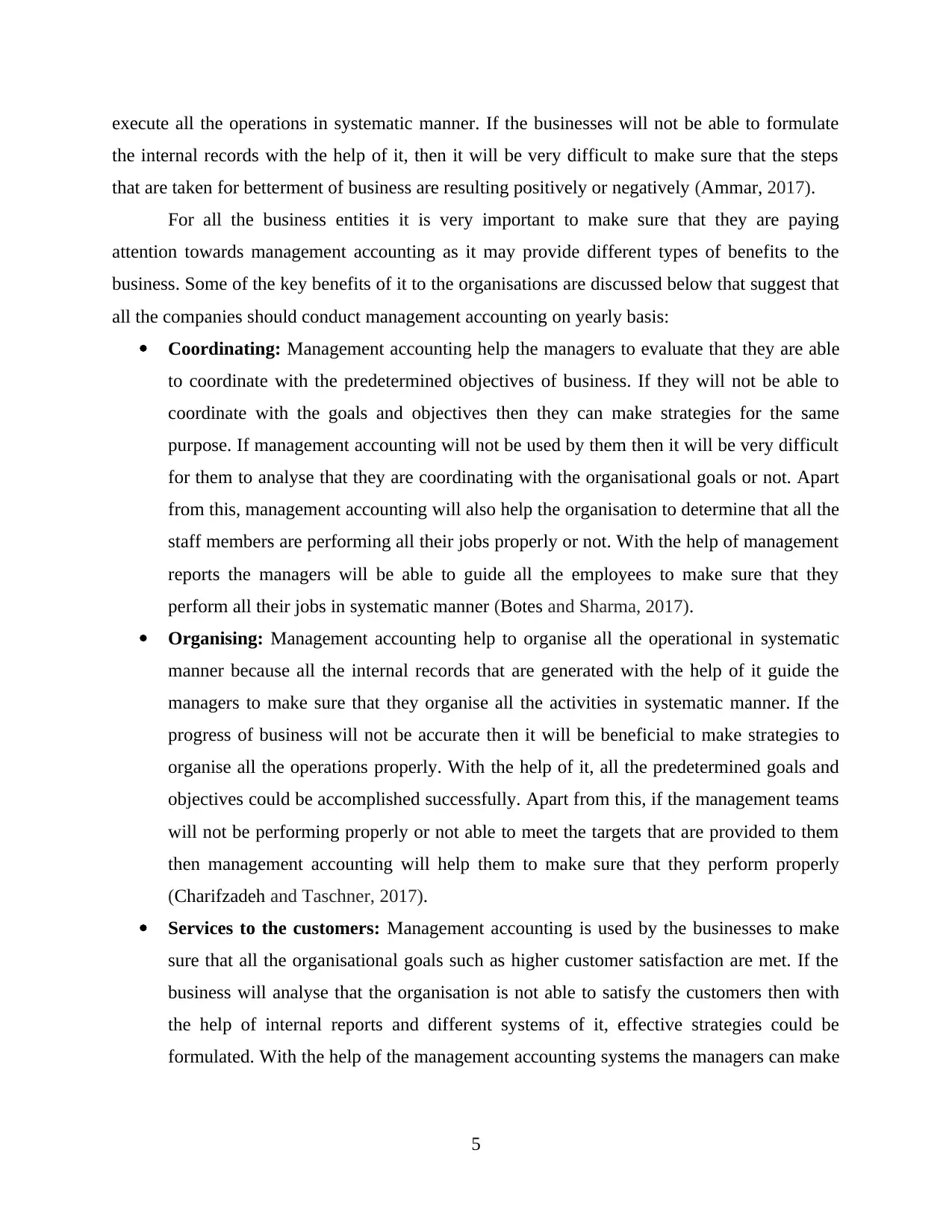
execute all the operations in systematic manner. If the businesses will not be able to formulate
the internal records with the help of it, then it will be very difficult to make sure that the steps
that are taken for betterment of business are resulting positively or negatively (Ammar, 2017).
For all the business entities it is very important to make sure that they are paying
attention towards management accounting as it may provide different types of benefits to the
business. Some of the key benefits of it to the organisations are discussed below that suggest that
all the companies should conduct management accounting on yearly basis:
Coordinating: Management accounting help the managers to evaluate that they are able
to coordinate with the predetermined objectives of business. If they will not be able to
coordinate with the goals and objectives then they can make strategies for the same
purpose. If management accounting will not be used by them then it will be very difficult
for them to analyse that they are coordinating with the organisational goals or not. Apart
from this, management accounting will also help the organisation to determine that all the
staff members are performing all their jobs properly or not. With the help of management
reports the managers will be able to guide all the employees to make sure that they
perform all their jobs in systematic manner (Botes and Sharma, 2017).
Organising: Management accounting help to organise all the operational in systematic
manner because all the internal records that are generated with the help of it guide the
managers to make sure that they organise all the activities in systematic manner. If the
progress of business will not be accurate then it will be beneficial to make strategies to
organise all the operations properly. With the help of it, all the predetermined goals and
objectives could be accomplished successfully. Apart from this, if the management teams
will not be performing properly or not able to meet the targets that are provided to them
then management accounting will help them to make sure that they perform properly
(Charifzadeh and Taschner, 2017).
Services to the customers: Management accounting is used by the businesses to make
sure that all the organisational goals such as higher customer satisfaction are met. If the
business will analyse that the organisation is not able to satisfy the customers then with
the help of internal reports and different systems of it, effective strategies could be
formulated. With the help of the management accounting systems the managers can make
5
the internal records with the help of it, then it will be very difficult to make sure that the steps
that are taken for betterment of business are resulting positively or negatively (Ammar, 2017).
For all the business entities it is very important to make sure that they are paying
attention towards management accounting as it may provide different types of benefits to the
business. Some of the key benefits of it to the organisations are discussed below that suggest that
all the companies should conduct management accounting on yearly basis:
Coordinating: Management accounting help the managers to evaluate that they are able
to coordinate with the predetermined objectives of business. If they will not be able to
coordinate with the goals and objectives then they can make strategies for the same
purpose. If management accounting will not be used by them then it will be very difficult
for them to analyse that they are coordinating with the organisational goals or not. Apart
from this, management accounting will also help the organisation to determine that all the
staff members are performing all their jobs properly or not. With the help of management
reports the managers will be able to guide all the employees to make sure that they
perform all their jobs in systematic manner (Botes and Sharma, 2017).
Organising: Management accounting help to organise all the operational in systematic
manner because all the internal records that are generated with the help of it guide the
managers to make sure that they organise all the activities in systematic manner. If the
progress of business will not be accurate then it will be beneficial to make strategies to
organise all the operations properly. With the help of it, all the predetermined goals and
objectives could be accomplished successfully. Apart from this, if the management teams
will not be performing properly or not able to meet the targets that are provided to them
then management accounting will help them to make sure that they perform properly
(Charifzadeh and Taschner, 2017).
Services to the customers: Management accounting is used by the businesses to make
sure that all the organisational goals such as higher customer satisfaction are met. If the
business will analyse that the organisation is not able to satisfy the customers then with
the help of internal reports and different systems of it, effective strategies could be
formulated. With the help of the management accounting systems the managers can make
5
Paraphrase This Document
Need a fresh take? Get an instant paraphrase of this document with our AI Paraphraser
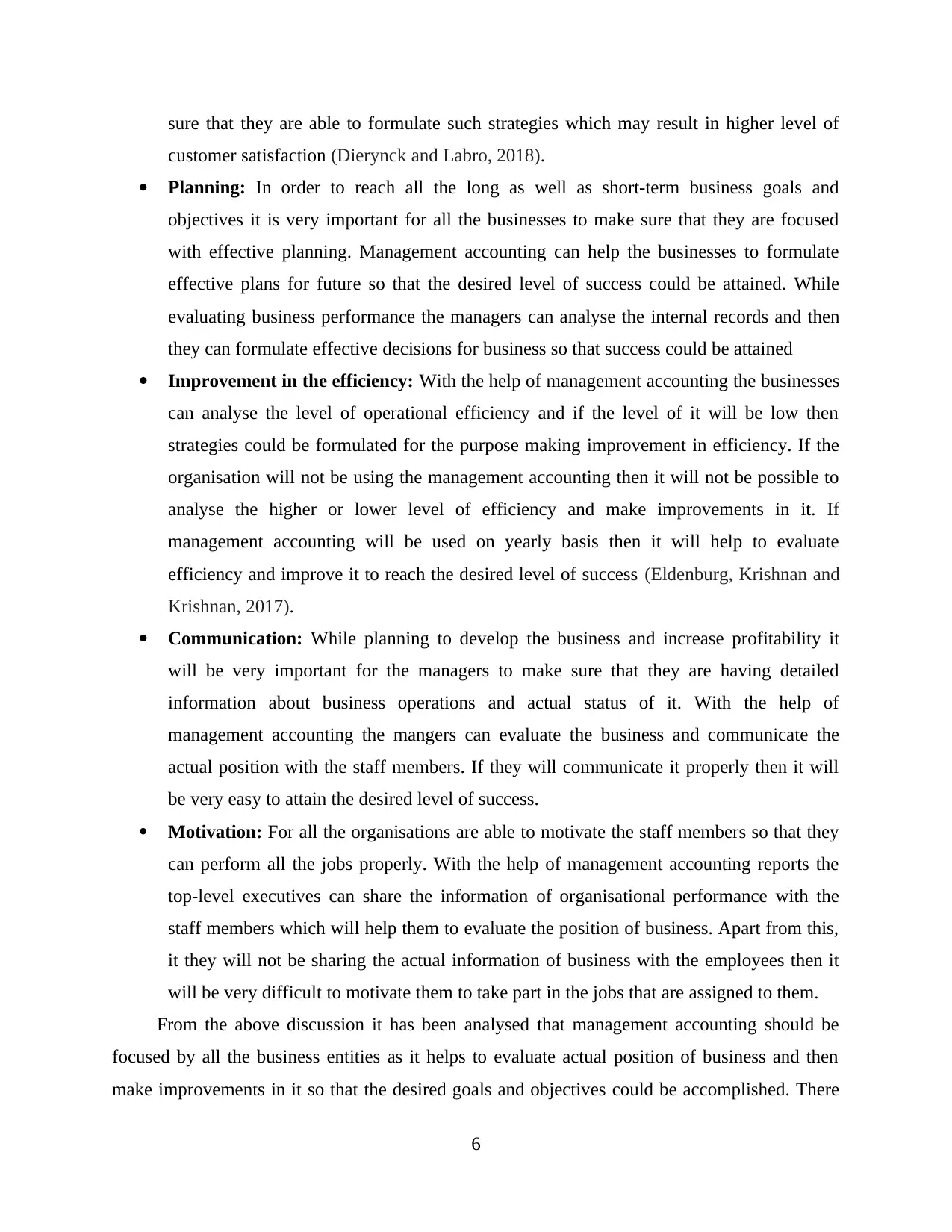
sure that they are able to formulate such strategies which may result in higher level of
customer satisfaction (Dierynck and Labro, 2018).
Planning: In order to reach all the long as well as short-term business goals and
objectives it is very important for all the businesses to make sure that they are focused
with effective planning. Management accounting can help the businesses to formulate
effective plans for future so that the desired level of success could be attained. While
evaluating business performance the managers can analyse the internal records and then
they can formulate effective decisions for business so that success could be attained
Improvement in the efficiency: With the help of management accounting the businesses
can analyse the level of operational efficiency and if the level of it will be low then
strategies could be formulated for the purpose making improvement in efficiency. If the
organisation will not be using the management accounting then it will not be possible to
analyse the higher or lower level of efficiency and make improvements in it. If
management accounting will be used on yearly basis then it will help to evaluate
efficiency and improve it to reach the desired level of success (Eldenburg, Krishnan and
Krishnan, 2017).
Communication: While planning to develop the business and increase profitability it
will be very important for the managers to make sure that they are having detailed
information about business operations and actual status of it. With the help of
management accounting the mangers can evaluate the business and communicate the
actual position with the staff members. If they will communicate it properly then it will
be very easy to attain the desired level of success.
Motivation: For all the organisations are able to motivate the staff members so that they
can perform all the jobs properly. With the help of management accounting reports the
top-level executives can share the information of organisational performance with the
staff members which will help them to evaluate the position of business. Apart from this,
it they will not be sharing the actual information of business with the employees then it
will be very difficult to motivate them to take part in the jobs that are assigned to them.
From the above discussion it has been analysed that management accounting should be
focused by all the business entities as it helps to evaluate actual position of business and then
make improvements in it so that the desired goals and objectives could be accomplished. There
6
customer satisfaction (Dierynck and Labro, 2018).
Planning: In order to reach all the long as well as short-term business goals and
objectives it is very important for all the businesses to make sure that they are focused
with effective planning. Management accounting can help the businesses to formulate
effective plans for future so that the desired level of success could be attained. While
evaluating business performance the managers can analyse the internal records and then
they can formulate effective decisions for business so that success could be attained
Improvement in the efficiency: With the help of management accounting the businesses
can analyse the level of operational efficiency and if the level of it will be low then
strategies could be formulated for the purpose making improvement in efficiency. If the
organisation will not be using the management accounting then it will not be possible to
analyse the higher or lower level of efficiency and make improvements in it. If
management accounting will be used on yearly basis then it will help to evaluate
efficiency and improve it to reach the desired level of success (Eldenburg, Krishnan and
Krishnan, 2017).
Communication: While planning to develop the business and increase profitability it
will be very important for the managers to make sure that they are having detailed
information about business operations and actual status of it. With the help of
management accounting the mangers can evaluate the business and communicate the
actual position with the staff members. If they will communicate it properly then it will
be very easy to attain the desired level of success.
Motivation: For all the organisations are able to motivate the staff members so that they
can perform all the jobs properly. With the help of management accounting reports the
top-level executives can share the information of organisational performance with the
staff members which will help them to evaluate the position of business. Apart from this,
it they will not be sharing the actual information of business with the employees then it
will be very difficult to motivate them to take part in the jobs that are assigned to them.
From the above discussion it has been analysed that management accounting should be
focused by all the business entities as it helps to evaluate actual position of business and then
make improvements in it so that the desired goals and objectives could be accomplished. There
6
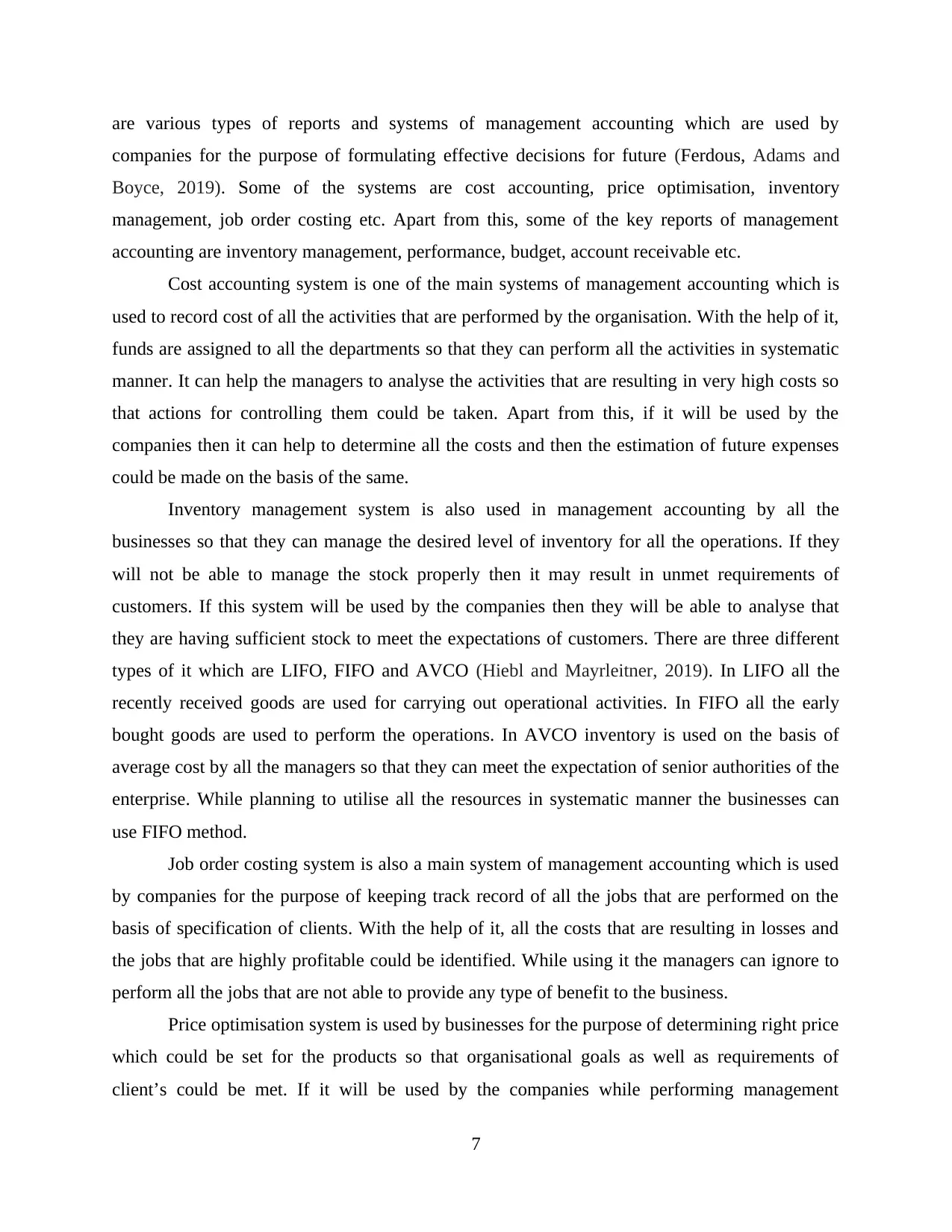
are various types of reports and systems of management accounting which are used by
companies for the purpose of formulating effective decisions for future (Ferdous, Adams and
Boyce, 2019). Some of the systems are cost accounting, price optimisation, inventory
management, job order costing etc. Apart from this, some of the key reports of management
accounting are inventory management, performance, budget, account receivable etc.
Cost accounting system is one of the main systems of management accounting which is
used to record cost of all the activities that are performed by the organisation. With the help of it,
funds are assigned to all the departments so that they can perform all the activities in systematic
manner. It can help the managers to analyse the activities that are resulting in very high costs so
that actions for controlling them could be taken. Apart from this, if it will be used by the
companies then it can help to determine all the costs and then the estimation of future expenses
could be made on the basis of the same.
Inventory management system is also used in management accounting by all the
businesses so that they can manage the desired level of inventory for all the operations. If they
will not be able to manage the stock properly then it may result in unmet requirements of
customers. If this system will be used by the companies then they will be able to analyse that
they are having sufficient stock to meet the expectations of customers. There are three different
types of it which are LIFO, FIFO and AVCO (Hiebl and Mayrleitner, 2019). In LIFO all the
recently received goods are used for carrying out operational activities. In FIFO all the early
bought goods are used to perform the operations. In AVCO inventory is used on the basis of
average cost by all the managers so that they can meet the expectation of senior authorities of the
enterprise. While planning to utilise all the resources in systematic manner the businesses can
use FIFO method.
Job order costing system is also a main system of management accounting which is used
by companies for the purpose of keeping track record of all the jobs that are performed on the
basis of specification of clients. With the help of it, all the costs that are resulting in losses and
the jobs that are highly profitable could be identified. While using it the managers can ignore to
perform all the jobs that are not able to provide any type of benefit to the business.
Price optimisation system is used by businesses for the purpose of determining right price
which could be set for the products so that organisational goals as well as requirements of
client’s could be met. If it will be used by the companies while performing management
7
companies for the purpose of formulating effective decisions for future (Ferdous, Adams and
Boyce, 2019). Some of the systems are cost accounting, price optimisation, inventory
management, job order costing etc. Apart from this, some of the key reports of management
accounting are inventory management, performance, budget, account receivable etc.
Cost accounting system is one of the main systems of management accounting which is
used to record cost of all the activities that are performed by the organisation. With the help of it,
funds are assigned to all the departments so that they can perform all the activities in systematic
manner. It can help the managers to analyse the activities that are resulting in very high costs so
that actions for controlling them could be taken. Apart from this, if it will be used by the
companies then it can help to determine all the costs and then the estimation of future expenses
could be made on the basis of the same.
Inventory management system is also used in management accounting by all the
businesses so that they can manage the desired level of inventory for all the operations. If they
will not be able to manage the stock properly then it may result in unmet requirements of
customers. If this system will be used by the companies then they will be able to analyse that
they are having sufficient stock to meet the expectations of customers. There are three different
types of it which are LIFO, FIFO and AVCO (Hiebl and Mayrleitner, 2019). In LIFO all the
recently received goods are used for carrying out operational activities. In FIFO all the early
bought goods are used to perform the operations. In AVCO inventory is used on the basis of
average cost by all the managers so that they can meet the expectation of senior authorities of the
enterprise. While planning to utilise all the resources in systematic manner the businesses can
use FIFO method.
Job order costing system is also a main system of management accounting which is used
by companies for the purpose of keeping track record of all the jobs that are performed on the
basis of specification of clients. With the help of it, all the costs that are resulting in losses and
the jobs that are highly profitable could be identified. While using it the managers can ignore to
perform all the jobs that are not able to provide any type of benefit to the business.
Price optimisation system is used by businesses for the purpose of determining right price
which could be set for the products so that organisational goals as well as requirements of
client’s could be met. If it will be used by the companies while performing management
7
⊘ This is a preview!⊘
Do you want full access?
Subscribe today to unlock all pages.

Trusted by 1+ million students worldwide
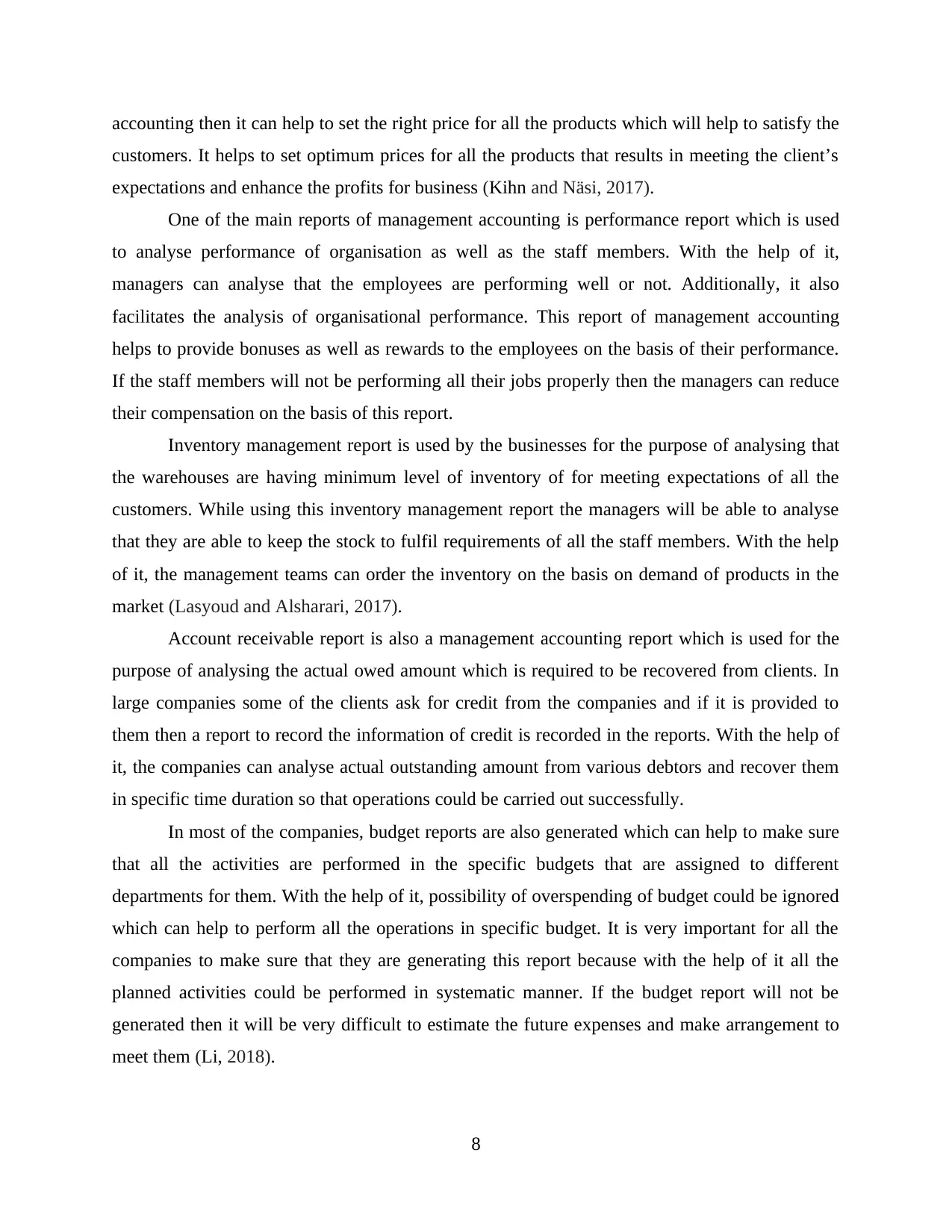
accounting then it can help to set the right price for all the products which will help to satisfy the
customers. It helps to set optimum prices for all the products that results in meeting the client’s
expectations and enhance the profits for business (Kihn and Näsi, 2017).
One of the main reports of management accounting is performance report which is used
to analyse performance of organisation as well as the staff members. With the help of it,
managers can analyse that the employees are performing well or not. Additionally, it also
facilitates the analysis of organisational performance. This report of management accounting
helps to provide bonuses as well as rewards to the employees on the basis of their performance.
If the staff members will not be performing all their jobs properly then the managers can reduce
their compensation on the basis of this report.
Inventory management report is used by the businesses for the purpose of analysing that
the warehouses are having minimum level of inventory of for meeting expectations of all the
customers. While using this inventory management report the managers will be able to analyse
that they are able to keep the stock to fulfil requirements of all the staff members. With the help
of it, the management teams can order the inventory on the basis on demand of products in the
market (Lasyoud and Alsharari, 2017).
Account receivable report is also a management accounting report which is used for the
purpose of analysing the actual owed amount which is required to be recovered from clients. In
large companies some of the clients ask for credit from the companies and if it is provided to
them then a report to record the information of credit is recorded in the reports. With the help of
it, the companies can analyse actual outstanding amount from various debtors and recover them
in specific time duration so that operations could be carried out successfully.
In most of the companies, budget reports are also generated which can help to make sure
that all the activities are performed in the specific budgets that are assigned to different
departments for them. With the help of it, possibility of overspending of budget could be ignored
which can help to perform all the operations in specific budget. It is very important for all the
companies to make sure that they are generating this report because with the help of it all the
planned activities could be performed in systematic manner. If the budget report will not be
generated then it will be very difficult to estimate the future expenses and make arrangement to
meet them (Li, 2018).
8
customers. It helps to set optimum prices for all the products that results in meeting the client’s
expectations and enhance the profits for business (Kihn and Näsi, 2017).
One of the main reports of management accounting is performance report which is used
to analyse performance of organisation as well as the staff members. With the help of it,
managers can analyse that the employees are performing well or not. Additionally, it also
facilitates the analysis of organisational performance. This report of management accounting
helps to provide bonuses as well as rewards to the employees on the basis of their performance.
If the staff members will not be performing all their jobs properly then the managers can reduce
their compensation on the basis of this report.
Inventory management report is used by the businesses for the purpose of analysing that
the warehouses are having minimum level of inventory of for meeting expectations of all the
customers. While using this inventory management report the managers will be able to analyse
that they are able to keep the stock to fulfil requirements of all the staff members. With the help
of it, the management teams can order the inventory on the basis on demand of products in the
market (Lasyoud and Alsharari, 2017).
Account receivable report is also a management accounting report which is used for the
purpose of analysing the actual owed amount which is required to be recovered from clients. In
large companies some of the clients ask for credit from the companies and if it is provided to
them then a report to record the information of credit is recorded in the reports. With the help of
it, the companies can analyse actual outstanding amount from various debtors and recover them
in specific time duration so that operations could be carried out successfully.
In most of the companies, budget reports are also generated which can help to make sure
that all the activities are performed in the specific budgets that are assigned to different
departments for them. With the help of it, possibility of overspending of budget could be ignored
which can help to perform all the operations in specific budget. It is very important for all the
companies to make sure that they are generating this report because with the help of it all the
planned activities could be performed in systematic manner. If the budget report will not be
generated then it will be very difficult to estimate the future expenses and make arrangement to
meet them (Li, 2018).
8
Paraphrase This Document
Need a fresh take? Get an instant paraphrase of this document with our AI Paraphraser
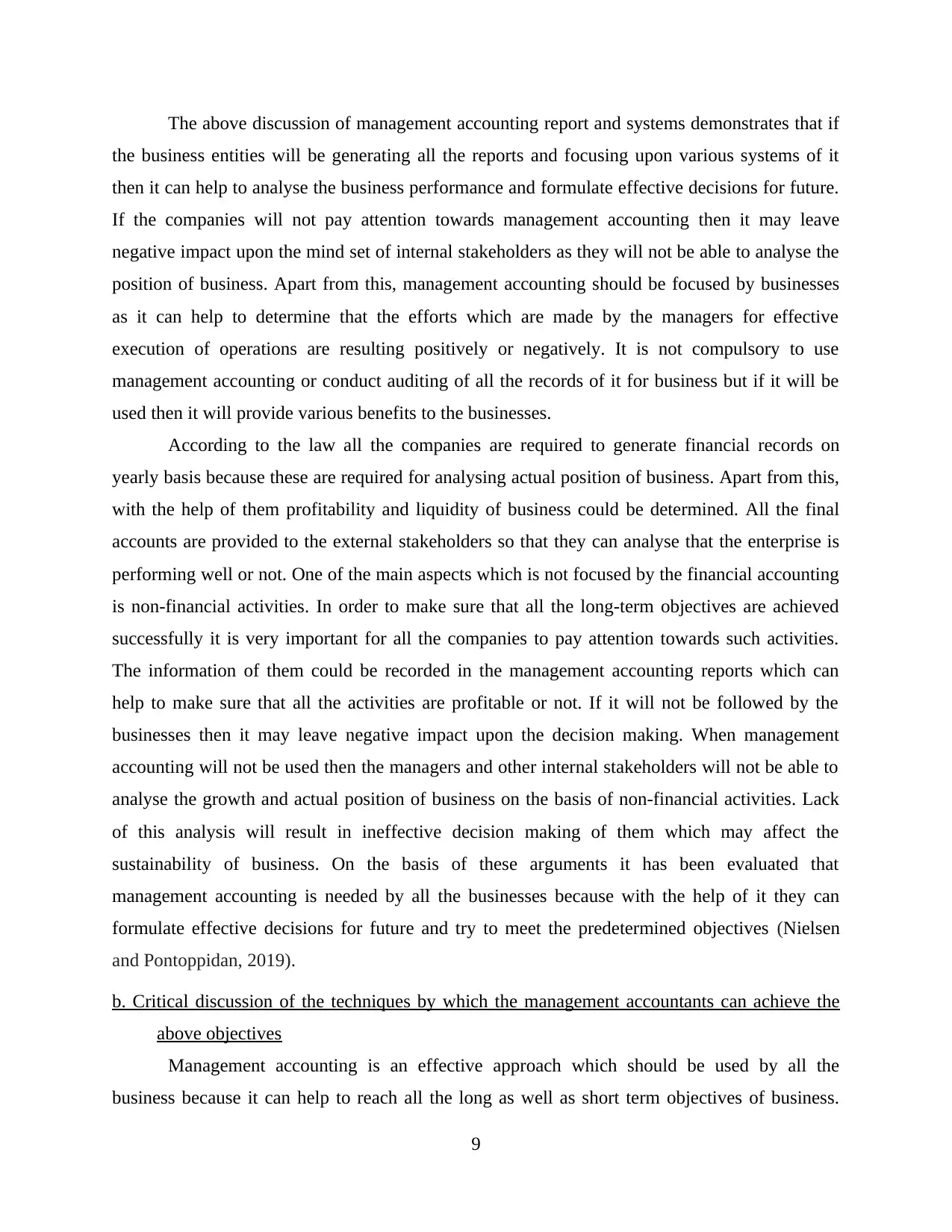
The above discussion of management accounting report and systems demonstrates that if
the business entities will be generating all the reports and focusing upon various systems of it
then it can help to analyse the business performance and formulate effective decisions for future.
If the companies will not pay attention towards management accounting then it may leave
negative impact upon the mind set of internal stakeholders as they will not be able to analyse the
position of business. Apart from this, management accounting should be focused by businesses
as it can help to determine that the efforts which are made by the managers for effective
execution of operations are resulting positively or negatively. It is not compulsory to use
management accounting or conduct auditing of all the records of it for business but if it will be
used then it will provide various benefits to the businesses.
According to the law all the companies are required to generate financial records on
yearly basis because these are required for analysing actual position of business. Apart from this,
with the help of them profitability and liquidity of business could be determined. All the final
accounts are provided to the external stakeholders so that they can analyse that the enterprise is
performing well or not. One of the main aspects which is not focused by the financial accounting
is non-financial activities. In order to make sure that all the long-term objectives are achieved
successfully it is very important for all the companies to pay attention towards such activities.
The information of them could be recorded in the management accounting reports which can
help to make sure that all the activities are profitable or not. If it will not be followed by the
businesses then it may leave negative impact upon the decision making. When management
accounting will not be used then the managers and other internal stakeholders will not be able to
analyse the growth and actual position of business on the basis of non-financial activities. Lack
of this analysis will result in ineffective decision making of them which may affect the
sustainability of business. On the basis of these arguments it has been evaluated that
management accounting is needed by all the businesses because with the help of it they can
formulate effective decisions for future and try to meet the predetermined objectives (Nielsen
and Pontoppidan, 2019).
b. Critical discussion of the techniques by which the management accountants can achieve the
above objectives
Management accounting is an effective approach which should be used by all the
business because it can help to reach all the long as well as short term objectives of business.
9
the business entities will be generating all the reports and focusing upon various systems of it
then it can help to analyse the business performance and formulate effective decisions for future.
If the companies will not pay attention towards management accounting then it may leave
negative impact upon the mind set of internal stakeholders as they will not be able to analyse the
position of business. Apart from this, management accounting should be focused by businesses
as it can help to determine that the efforts which are made by the managers for effective
execution of operations are resulting positively or negatively. It is not compulsory to use
management accounting or conduct auditing of all the records of it for business but if it will be
used then it will provide various benefits to the businesses.
According to the law all the companies are required to generate financial records on
yearly basis because these are required for analysing actual position of business. Apart from this,
with the help of them profitability and liquidity of business could be determined. All the final
accounts are provided to the external stakeholders so that they can analyse that the enterprise is
performing well or not. One of the main aspects which is not focused by the financial accounting
is non-financial activities. In order to make sure that all the long-term objectives are achieved
successfully it is very important for all the companies to pay attention towards such activities.
The information of them could be recorded in the management accounting reports which can
help to make sure that all the activities are profitable or not. If it will not be followed by the
businesses then it may leave negative impact upon the decision making. When management
accounting will not be used then the managers and other internal stakeholders will not be able to
analyse the growth and actual position of business on the basis of non-financial activities. Lack
of this analysis will result in ineffective decision making of them which may affect the
sustainability of business. On the basis of these arguments it has been evaluated that
management accounting is needed by all the businesses because with the help of it they can
formulate effective decisions for future and try to meet the predetermined objectives (Nielsen
and Pontoppidan, 2019).
b. Critical discussion of the techniques by which the management accountants can achieve the
above objectives
Management accounting is an effective approach which should be used by all the
business because it can help to reach all the long as well as short term objectives of business.
9
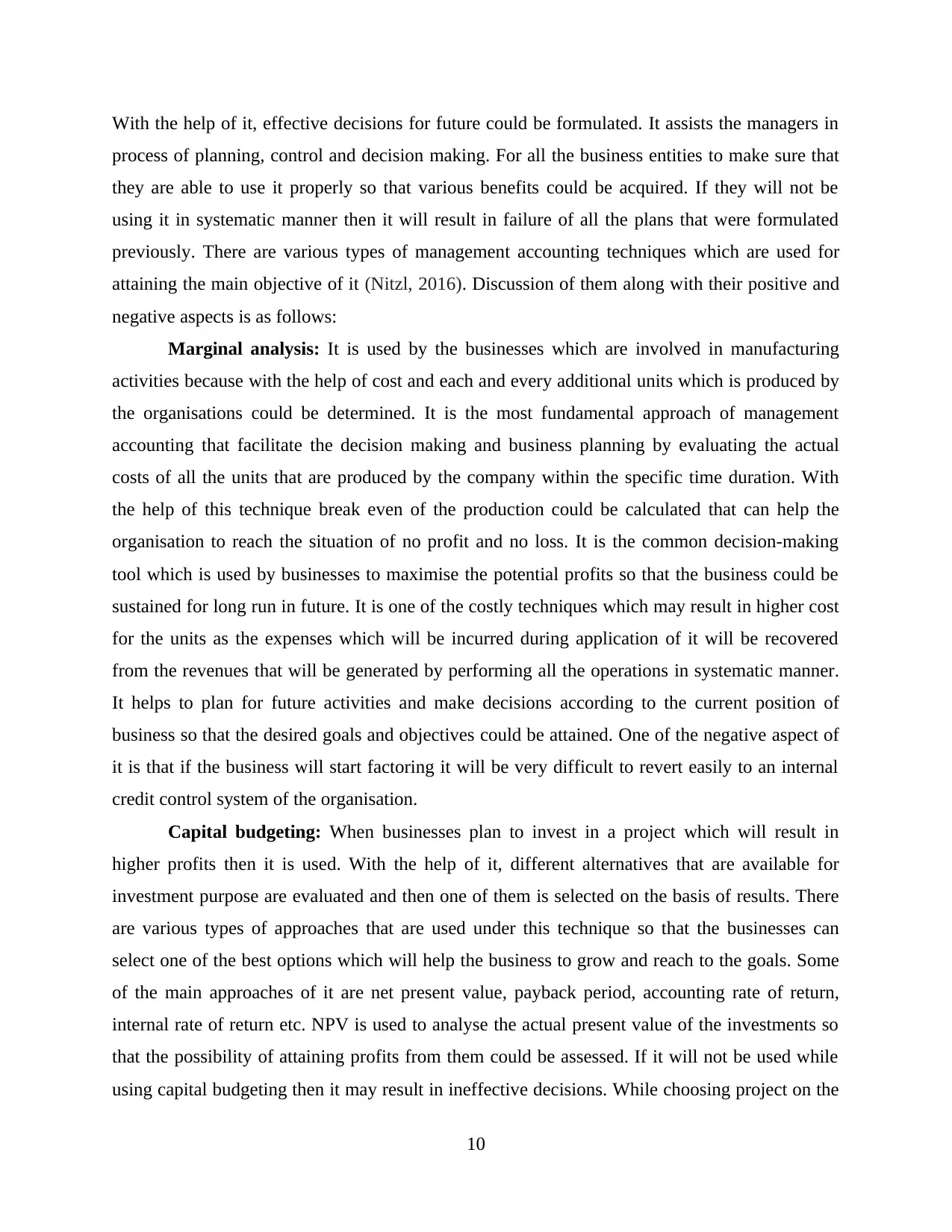
With the help of it, effective decisions for future could be formulated. It assists the managers in
process of planning, control and decision making. For all the business entities to make sure that
they are able to use it properly so that various benefits could be acquired. If they will not be
using it in systematic manner then it will result in failure of all the plans that were formulated
previously. There are various types of management accounting techniques which are used for
attaining the main objective of it (Nitzl, 2016). Discussion of them along with their positive and
negative aspects is as follows:
Marginal analysis: It is used by the businesses which are involved in manufacturing
activities because with the help of cost and each and every additional units which is produced by
the organisations could be determined. It is the most fundamental approach of management
accounting that facilitate the decision making and business planning by evaluating the actual
costs of all the units that are produced by the company within the specific time duration. With
the help of this technique break even of the production could be calculated that can help the
organisation to reach the situation of no profit and no loss. It is the common decision-making
tool which is used by businesses to maximise the potential profits so that the business could be
sustained for long run in future. It is one of the costly techniques which may result in higher cost
for the units as the expenses which will be incurred during application of it will be recovered
from the revenues that will be generated by performing all the operations in systematic manner.
It helps to plan for future activities and make decisions according to the current position of
business so that the desired goals and objectives could be attained. One of the negative aspect of
it is that if the business will start factoring it will be very difficult to revert easily to an internal
credit control system of the organisation.
Capital budgeting: When businesses plan to invest in a project which will result in
higher profits then it is used. With the help of it, different alternatives that are available for
investment purpose are evaluated and then one of them is selected on the basis of results. There
are various types of approaches that are used under this technique so that the businesses can
select one of the best options which will help the business to grow and reach to the goals. Some
of the main approaches of it are net present value, payback period, accounting rate of return,
internal rate of return etc. NPV is used to analyse the actual present value of the investments so
that the possibility of attaining profits from them could be assessed. If it will not be used while
using capital budgeting then it may result in ineffective decisions. While choosing project on the
10
process of planning, control and decision making. For all the business entities to make sure that
they are able to use it properly so that various benefits could be acquired. If they will not be
using it in systematic manner then it will result in failure of all the plans that were formulated
previously. There are various types of management accounting techniques which are used for
attaining the main objective of it (Nitzl, 2016). Discussion of them along with their positive and
negative aspects is as follows:
Marginal analysis: It is used by the businesses which are involved in manufacturing
activities because with the help of cost and each and every additional units which is produced by
the organisations could be determined. It is the most fundamental approach of management
accounting that facilitate the decision making and business planning by evaluating the actual
costs of all the units that are produced by the company within the specific time duration. With
the help of this technique break even of the production could be calculated that can help the
organisation to reach the situation of no profit and no loss. It is the common decision-making
tool which is used by businesses to maximise the potential profits so that the business could be
sustained for long run in future. It is one of the costly techniques which may result in higher cost
for the units as the expenses which will be incurred during application of it will be recovered
from the revenues that will be generated by performing all the operations in systematic manner.
It helps to plan for future activities and make decisions according to the current position of
business so that the desired goals and objectives could be attained. One of the negative aspect of
it is that if the business will start factoring it will be very difficult to revert easily to an internal
credit control system of the organisation.
Capital budgeting: When businesses plan to invest in a project which will result in
higher profits then it is used. With the help of it, different alternatives that are available for
investment purpose are evaluated and then one of them is selected on the basis of results. There
are various types of approaches that are used under this technique so that the businesses can
select one of the best options which will help the business to grow and reach to the goals. Some
of the main approaches of it are net present value, payback period, accounting rate of return,
internal rate of return etc. NPV is used to analyse the actual present value of the investments so
that the possibility of attaining profits from them could be assessed. If it will not be used while
using capital budgeting then it may result in ineffective decisions. While choosing project on the
10
⊘ This is a preview!⊘
Do you want full access?
Subscribe today to unlock all pages.

Trusted by 1+ million students worldwide
1 out of 17
Related Documents
Your All-in-One AI-Powered Toolkit for Academic Success.
+13062052269
info@desklib.com
Available 24*7 on WhatsApp / Email
![[object Object]](/_next/static/media/star-bottom.7253800d.svg)
Unlock your academic potential
Copyright © 2020–2025 A2Z Services. All Rights Reserved. Developed and managed by ZUCOL.




